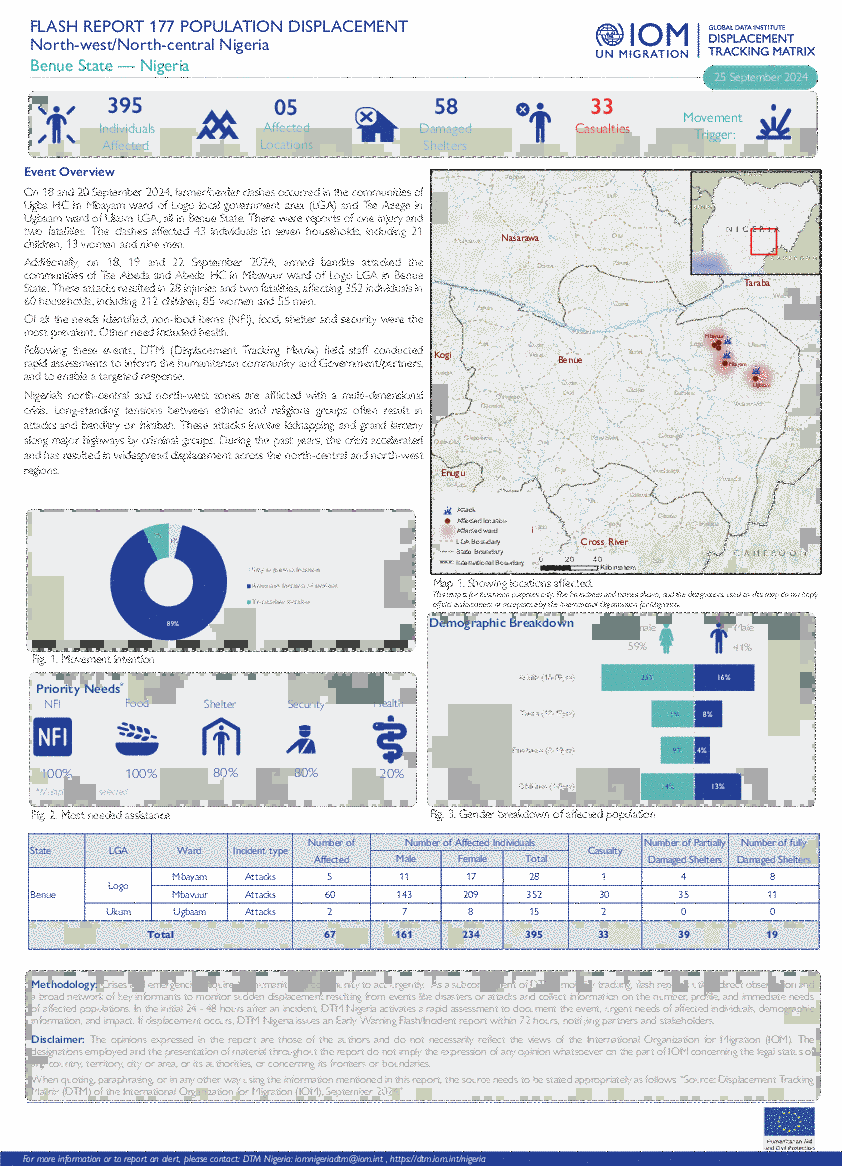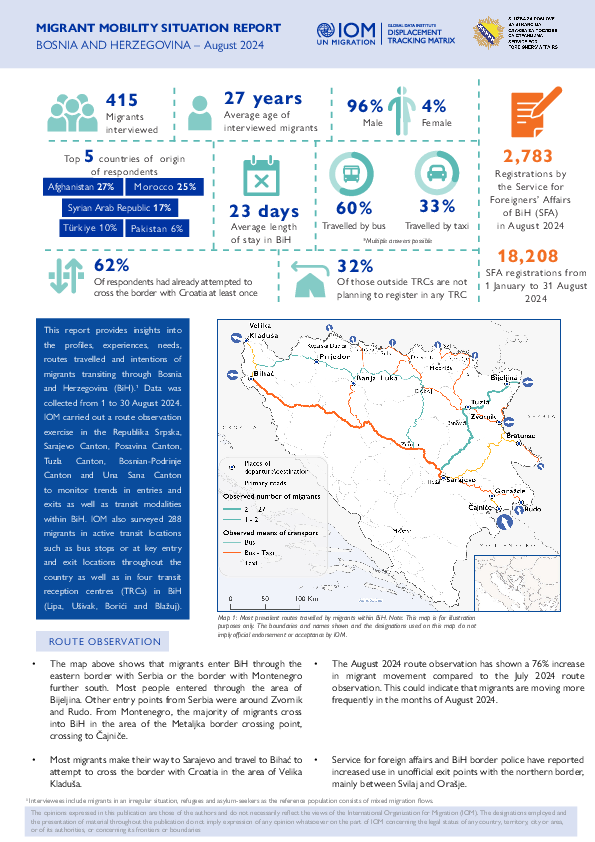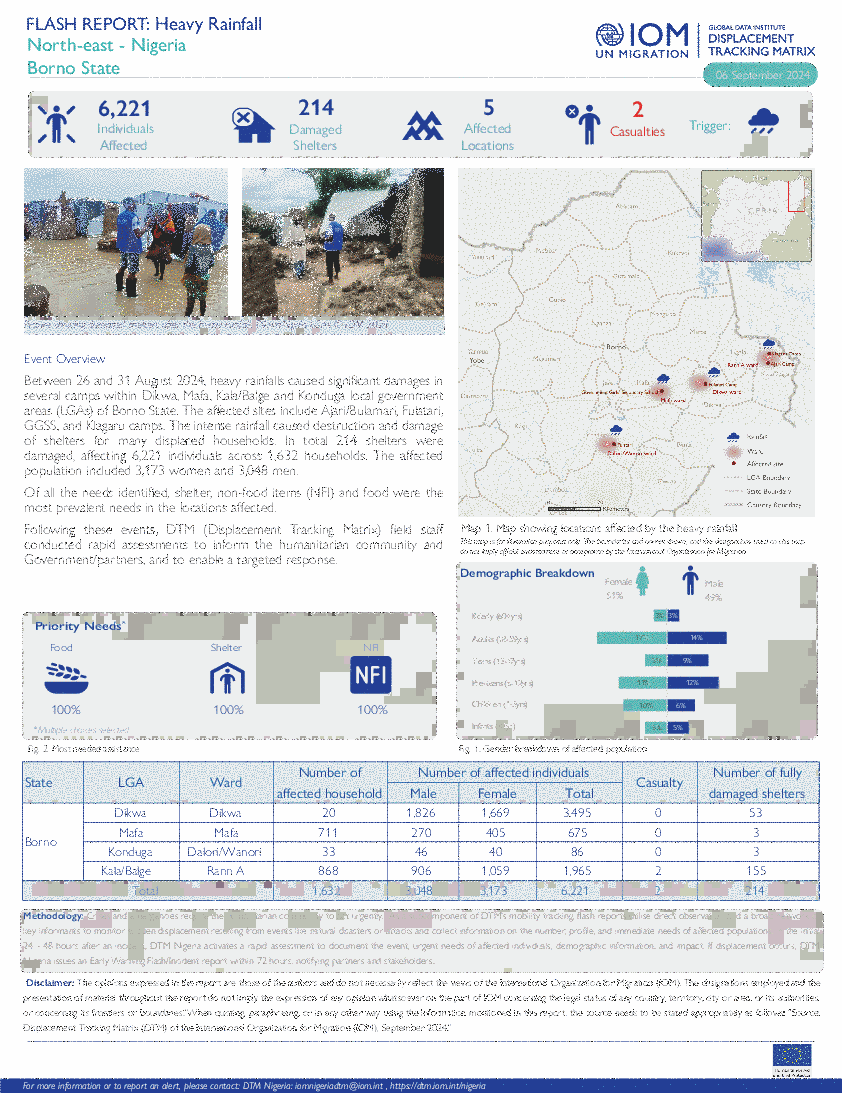-
Countries
-
Data and Analysis
-
Special Focus
-
Crisis Responses
Situation Report

Contact
DTM Chad, dtmtchad@iom.int
Language
French
Location
Chad
Period Covered
Aug 14 2024
Aug 28 2024
Activity
- Mobility Tracking
- Event Tracking
Environ 910 000 personnes sont estimées avoir traversé la frontière vers le Tchad depuis le début de la crise au Soudan, incluant 213 339 parmi eux qui sont des retournés tchadiens depuis fin juillet. L’OIM s’attend à ce que ce nombre passe à 240 000 d’ici fin décembre 2024, en raison de la reprise du conflit au Darfour.

Contact
DTM Chad, dtmtchad@iom.int
Language
English
Location
Chad
Period Covered
Sep 14 2024
Sep 27 2024
Activity
- Mobility Tracking
- Event Tracking
An estimated 910,000 people have crossed into Chad since the onset of the crisis in Sudan, of which 213,339 are Chadian returnees as of end of July 2023. IOM expects this number to rise to 240,000 in December 2024. This is due to ongoing conflict and food insecurity in Darfur, owing to the current suspension of the humanitarian corridor between Chad and Darfur.

Contact
DTM Yemen, iomyemendtm@iom.int
Language
English
Location
Yemen
Period Covered
Sep 22 2024
Sep 28 2024
Activity
- Mobility Tracking
- Event Tracking
IOM Yemen DTM's Rapid Displacement Tracking (RDT) tool collects data on estimated numbers of households forced to flee on a daily basis from their locations of origin or displacement, allowing for regular reporting of new displacements in terms of estimated numbers, geography, and needs. It also tracks returnees who returned to their location of origin.
From 1 January to 28 September 2024, IOM Yemen DTM tracked 2,725 households (HH) (16,350 Individuals) who experienced displacement at least once.
Between 22 and 28 September 2024, IOM Yemen DTM tracked 23 households (138 individuals) displaced at least once. The majority of people moved into/within the following governorates and districts:
- Ma'rib (11 HH) – Ma'rib City (9 HHs), Ma'rib (2 HHs) districts. Most displacements in the governorate originated from Ibb and Dhamar.
- Ta'iz (10 HHs) – Al Makha (6 HHs), Al Mudhaffar (3 HHs), Al Misrakh (1 HH) districts. Most displacements in the governorate were internal.
- Al Hodeidah (2 HHs) – Al Khukhah (1 HH), Hays (1 HH) districts. Most displacements in the governorate originated from Ta'iz and Al Hodeidah.
The majority of people moved from the following governorates and districts:
- Ta'iz (10 HHs) – Mawza (4 HHs), Maqbanah (3 HHs), Sharab Ar Rawnah (2 HHs) districts.
- Lahj (2 HHs) – Al Qubaytah (2 HHs) district.
- Dhamar (2 HHs) – Al Hada (2 HHs) district.
IOM identified 23 additional households displaced in the previous reporting period, which covered 15 - 21 September 2024, in the governorates of Ta'iz (17 HHs), Al Hodeidah (5 HHs), and Ma'rib (1 HH). These figures have been added to the cumulative displacement total recorded since the beginning of the year.

Contact
DTM Nigeria, iomnigeriadtm@iom.int
Language
English
Location
Nigeria
Period Covered
Sep 16 2024
Sep 22 2024
Activity
- Mobility Tracking
- Event Tracking
On 18 and 20 September 2024, farmer/herder clashes occurred in the communities of Ugba HC in Mbayam ward of Logo local government area (LGA) and Tse Azege in Ugbaam ward of Ukum LGA, all in Benue State. There were reports of one injury and two fatalities. The clashes affected 43 individuals in seven households, including 21 children, 13 women and nine men.
Additionally, on 18, 19 and 22 September 2024, armed bandits attacked the communities of Tse Abeda and Abeda HC in Mbavuur ward of Logo LGA in Benue State. These attacks resulted in 28 injuries and two fatalities, affecting 352 individuals in 60 households, including 212 children, 85 women and 55 men.
This report focuses on individuals residing abroad who are either visiting Ukraine for a short period or have been living abroad and intend to return to Ukraine. For the first time in the Crossing Back Survey report series, this analysis excludes those who reside in Ukraine and are returning after a short visit abroad (n=544). This adjustment has significantly reduced the sample size of prospective returnees compared to previous quarters. Consequently, comparisons of the proportions of short-term visitors and prospective returnees to previous quarters are not valid.
Sections 1 to 7 focus on 4,030 surveys with adult Ukrainian nationals met at the border areas of neighbouring countries: Poland (187), Republic of Moldova (1,677), Romania (1,027), and Slovakia (1,139). In Section 8, evidence on persons interviewed while crossing back is complemented with data on returnees from abroad collected by DTM in Ukraine. Due to a low number of respondents, data from Hungary is excluded from the regional analysis and discussed separately in Section 9. The report also discusses the different profiles of Ukrainian nationals crossing back from Latvia to the Russian Federation with the aim to reach occupied areas of Ukraine. Those crossing back from Latvia are also presented separately in Section 10 because of the low number of respondents. The report ends with a short section elaborating on the Methodology.
Key findings:
- Among 4,030 Ukrainians, 93% were women and 7% were men.
- 11% of respondents were prospective returnees, 73% were short-term visitors and 16% were undecided.
- 66% stayed in neighbouring countries prior to crossing back
- Top reasons to cross back included: Meeting family members (51%), receiving medical care (23%), obtain/renew documents (23%), help with family responsibilities (16%), and check on property (12%).
- 73% of respondents received aid while abroad.
- Top 5 needs included: Financial support (24%), health services (21%), personal safety and security (18%), general information (13%) and assistance with documentation (9%).

Contact
iomaccra@@iom.int
Language
English
Location
Ghana
Period Covered
Sep 08 2024
Sep 11 2024
Activity
- Mobility Tracking
Rising water levels upstream from the Akosombo Dam, primarily due to heavy rainfall caused the Volta River Authority to spill excess water on 15 September 2023. The spillage has caused flooding in communities downstream of the dam, destroying homes and farmland along the banks of the River Volta. Therefore, some communities were displaced into safe havens (also known as collective centers) in the districts of Ada East, Central Tongu, North Tongu and Shai Osudoku.
To update population figures in the safe havens, the National Disaster Management Organization (NADMO), with technical and financial support of the International Organization for Migration (IOM), deployed the DTM-developed Standard Registration Tool. This initiative, carried out in collaboration with the World Food Programme, World Vision and the Ghanaian Federation of Persons with Physical Disabilities, took place between 14 and 17 November 2023. Thirty enumerators conducted registrations across 25 safe havens in the affected districts, recording over 7,000 internally displaced persons (IDPs) from 1,492 households. The deployment provided detailed data and an in-depth analysis of the specific needs of these households.

Contact
MTM Tajikistan (mtmtajikistan@iom.int); DTM REMAP Support Team (dtmremapsupport@iom.int)
Language
English
Location
Tajikistan
Period Covered
Jan 01 2024
Jun 30 2024
Activity
- Flow Monitoring
- Mobility Tracking
This report aims to provide an overview of the migration patterns and mobility in Tajikistan, drawing upon data from the latest available sources between January to June 2024 from national and international datasets on migratory movements concentrating on the most recent migration situation in Tajikistan. This includes migration flow, number of residences permits and remittances, as well as reasons for migration. The report includes the continuing impact of the Russian invasion of Ukraine on traditional migration corridors in the region, changing labour migration flows, increase of climate change and migration concerns, the growing urbanization process, the social-economic circumstances, and other major events described as main contributing factors of the human mobility and migratory movements in the given period in the country. Additionally, the report also narrates the impacts of the tragic incident on the Crocus City Hall in Krasnogorsk near Moscow carried out on 22 March 2024 by Islamic State-Khorasan (ISIS-K), which involved Tajik migrants as perpetrators on migratory movements.

Contact
DTM Europe, DTMMediterranean@iom.int
Language
English
Location
Bosnia & Herzegovina
Period Covered
Aug 01 2024
Aug 31 2024
Activity
- Flow Monitoring
This report provides insights into the profiles, experiences, needs, routes travelled and intentions of migrants transiting through Bosnia and Herzegovina (BiH). Data was collected from 1 to 30 August 2024. IOM carried out a route observation exercise in the Republika Srpska, Sarajevo Canton, Posavina Canton, Tuzla Canton, Bosnian-Podrinje Canton and Una Sana Canton to monitor trends in entries and exits as well as transit modalities within BiH. IOM also surveyed 288 migrants in active transit locations such as bus stops or at key entry and exit locations throughout the country as well as in four transit reception centres (TRCs) in BiH (Lipa, Ušivak, Borići and Blažuj).

Contact
MTM Kazakhstan (mtmkazakhstan@iom.int) DTM REMAP Support Team (dtmremapsupport@iom.int)
Language
English
Location
Kazakhstan
Period Covered
Feb 15 2024
Apr 30 2024
Activity
- Survey
- Return Intention
- Mobility Tracking
- Baseline Assessment
DTM implements the Baseline Mobility Assessment (BMA) in Kazakhstan to track mobility, provide information on population estimates, geographic distribution of migrant workers, return migrants, and emigrants, reasons for migration and countries of origin, return, and destination. Data is collected at the community (micro districts, townships, and villages) level from key informants and direct observations.
The Baseline Mobility Assessment (BMA) was conducted in seven oblasts or provinces (Abay, Almaty, Kostanay, Kyzylorda, Mangystau, North Kazakhstan, and Turkestan), and three major cities of Kazakhstan namely Shymkent city, Almaty city, and Astana city. This assessment covered 1,301 communities through interviews with 1,923 key informants. Based on the key informants' estimates, 598,094 international migrant workers were hosted in the assessed locations in Kazakhstan from 2020 to April 2024. Concurrently, 29,853 internal migrants were hosted in the assessed locations, and 3,224 Kazakh nationals were reported to be residing abroad as international migrants. In addition, 17,317 Kazakh migrants have returned from abroad.

Contact
DTM Nigeria, iomnigeriadtm@iom.int
Language
English
Location
Nigeria
Period Covered
Aug 26 2024
Aug 31 2024
Activity
- Mobility Tracking
- Event Tracking
Between 26 and 31 August 2024, heavy rainfalls caused significant damages in several camps within Dikwa, Mafa, Kala/Balge and Konduga local government areas (LGAs) of Borno State. The affected sites include Ajari/Bulamari, Fulatari, GGSS, and Klagaru camps. The intense rainfall caused destruction and damage to shelters for many displaced households. In total 214 shelters were damaged, affecting 6,221 individuals across 1,632 households. The affected population included 3,173 women and 3,048 men.
Pagination
- Previous page
- Page 8
- Next page

